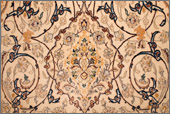
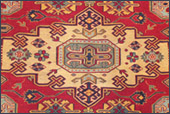
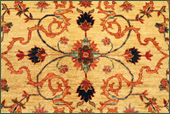
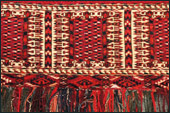
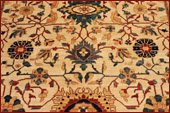
WEAVING TYPES
Studying an Oriental Rug’s weave type, colours, pattern and design motifs can help us to discover and further determine its style, origins and provenance. Here, a two-dimensional, flat surface is being conceptualised in a three-dimensional ‘infinite space’ using a series of rug layers, consisting of the main central field, multiple borders, and fringe edgings, where the main pattern of motifs are repeated in varying forms, throughout the rug’s design.
There are two hand-woven rug techniques: flatweaves (also known as plain weaves) are created without a knot or pile, such as kilims, sofras, soumaks and aubussons. Knotted weaves produce a pile, where the asymmetric Persian or ‘Senneh’ knot and the symmetric Turkish or ‘Ghiordes’ knot are the rug knots types most commonly used. Depending on the style, yarns, size and pattern, a hand-woven rug can take from a few months to several years to complete. (From top see fig: 1 & 2)
Hand-woven Oriental Rugs fall into three main weaving categories or styles:
Tribal Weaves: are woven from memory by nomadic peoples, where their creation is dependent on the migratory journeys, trade routes and weaving materials availability for barter. Weavings range from salt bags to chuvals and juvals (bags), ensis (decorative door hangings) and hearth rugs – all displaying geometric designs that can either be simplistic or complex in nature such as: Baluch, Turkmen and Caucasian pieces. Yarns include wool, camel, goat and horsehair, with occasional highlights in silk, and decorated with beads and embroidery. (From top see fig: 3)
Village Weaves: are woven by ‘settled’ master rug-weaving families on custom-built, static rug looms in their cottage homes. Here, pieces are woven mainly with wool or mohair on a cotton foundation, displaying a variety of loose geometric and decoratively-imbued floral patterns, in a palette of soft or vibrant colourways and designs. (From top see fig: 4)
City Weaves: are produced in professional rug workshops on looms using a pre-designed pattern template known as a ‘naqshia’ to create complex and intricately woven designs, with finely detailed ornamentation and a high knot density, such as authentic Persian silk and wool-mix and all-silk weavings. (From top see fig: 5)


